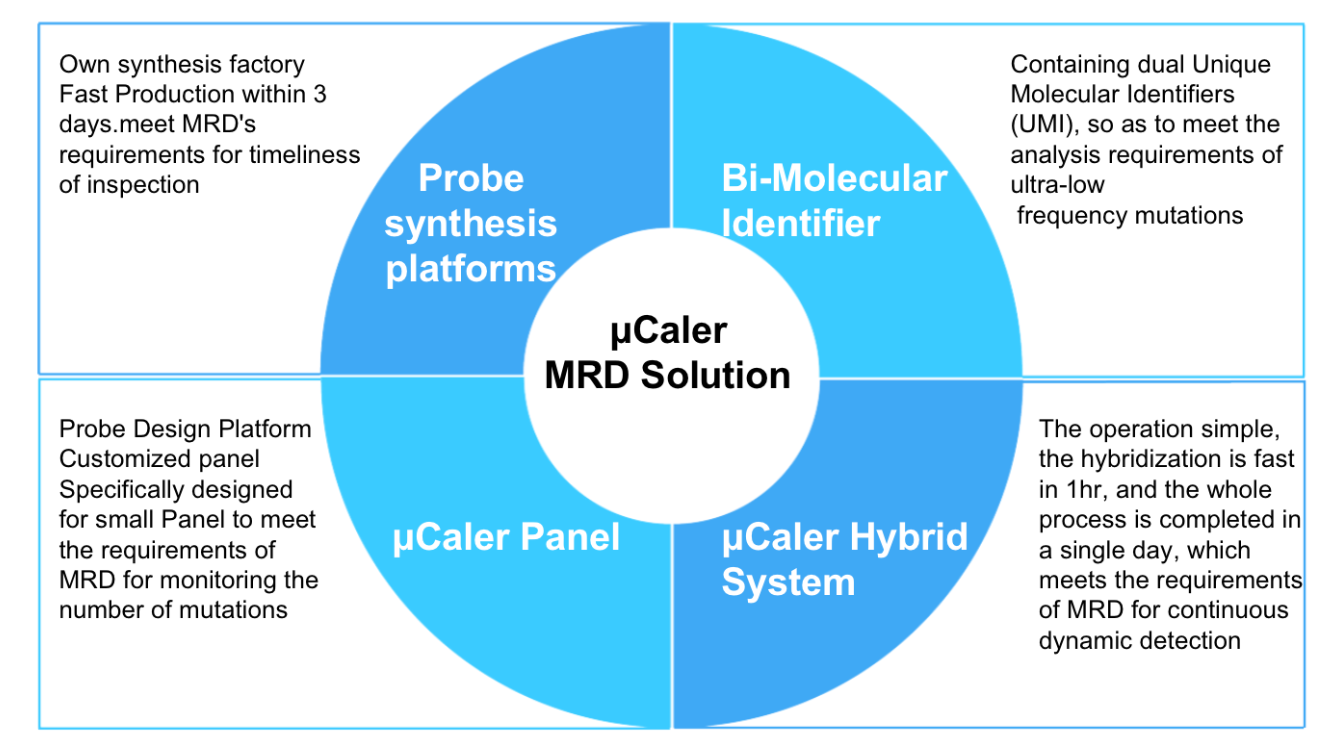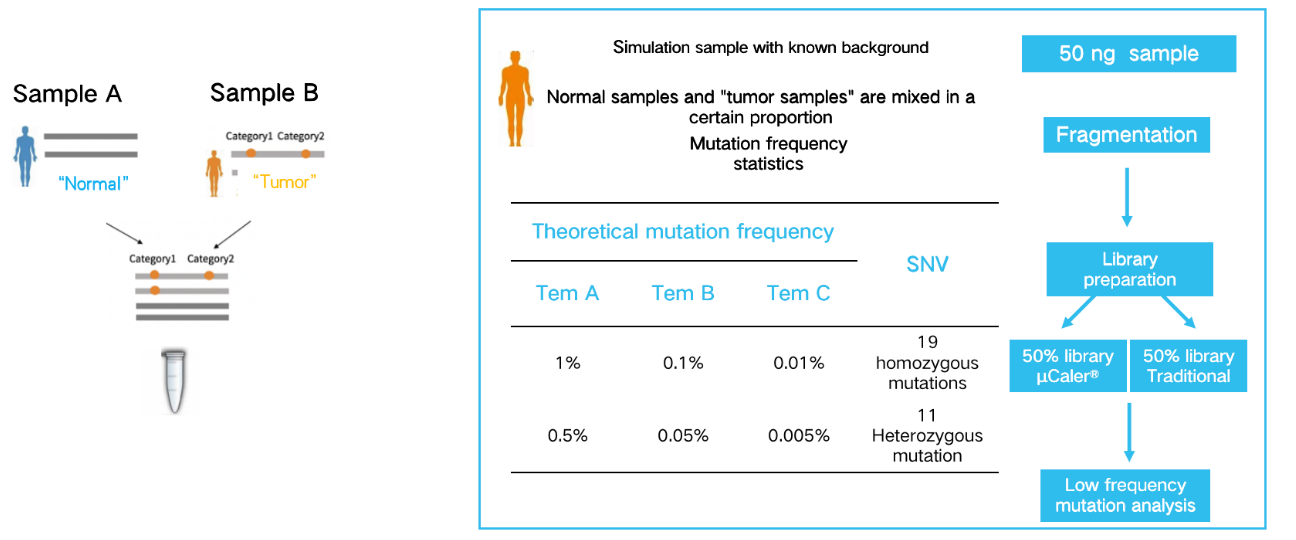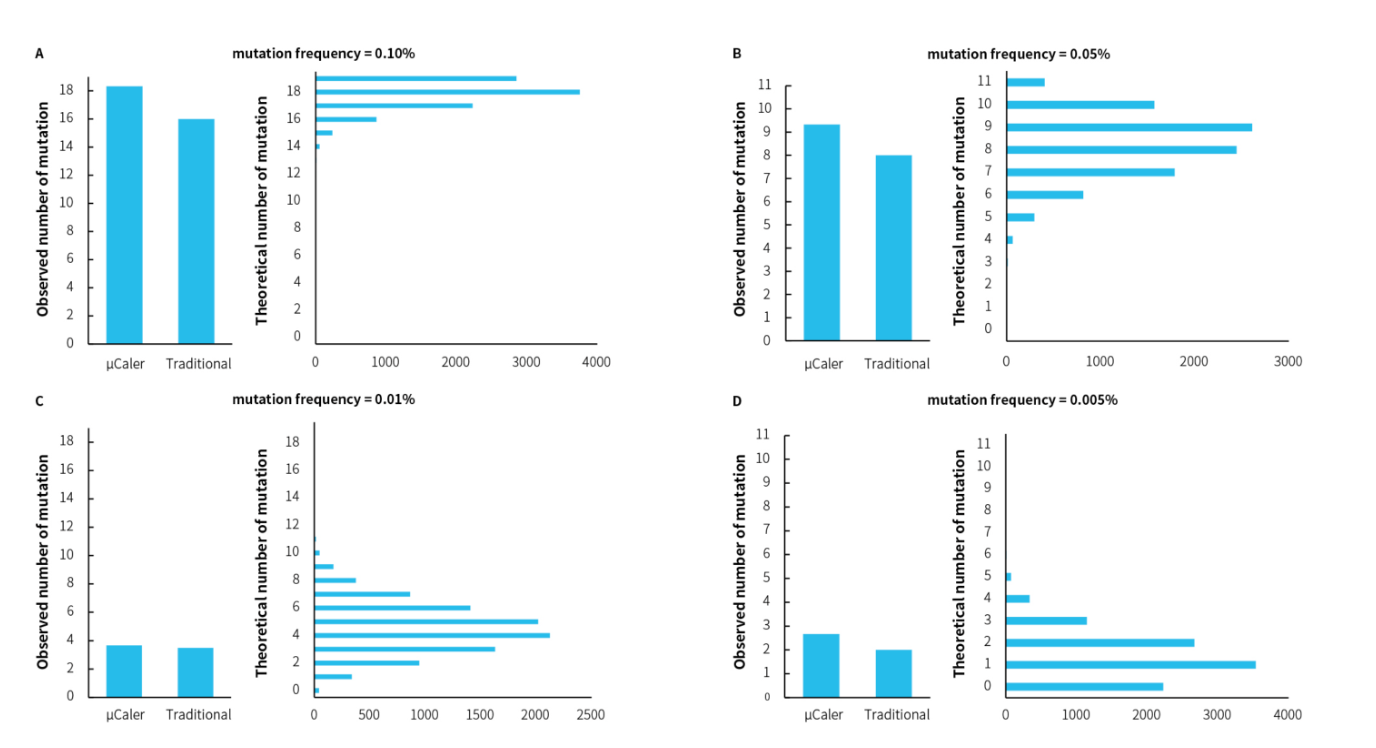New Product Launch|MRD solution based on μCaler Hybrid System
Current in clinical implementation are usually to collect a volume of > 5 mL of blood per patient,with the median concentration of cfDNA at approximatively 7,500 genome copies[1]. Given the total amount of cfDNA, methods based NGS can simultaneously detect mutations at multiple loci, which can increase the detection rate of ctDNA in liquid biopsy, and thus meet the standard of MRD detection that requires stable detection of ctDNA with abundance≥0.02%[2]. Tumor informed sequencing firstly obtains the patient's variation map by comprehensively genome sequencing of the primary tumor tissue, and then customizes personalized panel targeting only a certain number of known mutation loci for ctDNA detection and variation analysis, which can maximize sensitivity. However, this approach is laborious, and might require intensive optimization, synthesis and validation of the panels in a very short time before being economically viable, hampering a rapid translation to clinical practice.
TheμCaler Hybrid System mentioned in the previous chapter, the rapid binding of multiple probe conjugation effects makes the Kb-level panels have excellent performance in capture stability. Therefore, we combined the advantages ofμCaler with MRD detection application to solve the disadvantage points of traditional hybrid capture approaches.
Therefore, we combined the advantages ofμCaler technology with MRD detection application to solve the disacvantage points of traditional hybrid capture methods.
μCaler Solution for MRD Detection
μCaler MRD Solution (for Illumina®) is equipped with adapters containing dual Unique Molecular Identifiers (UMI), so as to meet the analysis requirements of ultra-low frequency mutations in plasma circulating cell-free DNA for MRD detection; in addition, this solution is designed for targeted enrichment of small Panel, integrated with upgraded and optimized hybrid capture and elution processes, and equipped withμCaler Panel designed based on brand-new creative scheme, which can complete the whole process of capture-library preparation in same day.μCaler Panel is commercialized or customized Panel (μCaler Custom Panel) designed based on Nanodigmbio's independent intellectual property rights. Extremely fast delivery in 3 days (Chinese Mainland only) (Fig 1.).

Fig 1. Service support forμCaler MRD Solution.
Detection of Ultra-low Frequency Mutation
gDNA from two healthy donors with known mutation was mixed at ratios of 99:1, 999:1, and 9999:1 to artificially mimic samples with different mutation frequencies. Category 1 contain 19 homozygous mutation with the frequency of 1% (Tem A), 0.1% (Tem B) and 0.01% (Tem C) respectively, and category 2 contain 11 heterozygous mutation with the frequency of 0.5% (Tem A), 0.05% (Tem B) and 0.005% (Tem C) respectively (Fig 2.).

Fig 2. Simulated samples for analysis of low frequency mutations and experimental design.

Fig 3. Detection of low-frequency mutations byμCaler Panel and Traditional Panel. 50ng simulated samples were used byμCaler MRD Solution (for Illumina®) coupled withμCaler Panel (about 3 Kb target region, covering 30 allelic loci) and NadPrep Hybrid Capture System coupled with Traditional Panel (about 42 Kb target region, covering 160 allelic loci, including the above 30 loci) respectively, and sequenced on Illumina Novaseq 6000 with PE150. Each pair of samples was subjected to the same depth (pre-library containing UMI) for three downsampling, and the detection of the mutation site was analyzed by Duplex Consensus Sequences (DCS211) as well as single-strand consensus sequences (family size≥3) (SSCS≥3). Average valid reads supporting mutations≥1 are judged as positive.

Fig 4. Comparative analysis of detection and theoretical detection for low-frequency mutations byμCaler Panel and Traditional Panel.
Note: Theoretical number of mutation is 2,750x of DCS211 depth; the distribution rule of mutation detection by 10,000 random sampling for different mutation frequencies.
Conclusion
MRD detection based on NGS can detect signals that cannot be detected by traditional techniques such as imaging or serology. However, missed detection or wrong judgment will cause patients to miss the best treatment time or undertake the risk of over treatment. We should take into account the positive predictive value of detection while pursuing sensitivity. AlthoughμCaler MRD Solution has simplified the operation process, but its capture performance is still better than that of traditional hybrid capture scheme, which is conducive to the rapid translation of clinical MRD detection.
Order information

Solutions
- Methyl Library Preparation Total Solution
- Sequencing single library on different platform--Universal Stubby Adapter (UDI)
- HRD score Analysis
- Unique Dual Index for MGI platforms
- RNA-Cap Sequencing of Human Respiratory Viruses Including SARS-CoV-2
- Total Solution for RNA-Cap Sequencing
- Total Solution for MGI Platforms
- Whole Exome Sequencing
- Low-frequency Mutation Analysis
Events
-
Exhibition Preview | Nanodigmbio invites you to join us at Boston 2025 Annual Meeting of the American Society of Human Genetics (ASHG)

-
Exhibition Preview | Nanodigmbio Invites You to Join Us at WHX & WHX Labs Kuala Lumpur 2025, Malaysia International Trade and Exhibition Centre in Kuala Lumpur

-
Exhibition Preview | Nanodigmbio Invites You to Join Us at Hospitalar 2025, Brazil International Medical Device Exhibition in São Paulo

-
Exhibition Preview | Nanodigmbio invites you to join us at Denver 2024 Annual Meeting of the American Society of Human Genetics (ASHG)

-
Exhibition Preview | Nanodigmbio invites you to join us at Sapporo 2024 Annual Meeting of the Japan Society of Human Genetics (JSHG)

-
Exhibition Preview | Nanodigmbio invites you to join us at Association for Diagnostics & Laboratory Medicine (ADLM)



